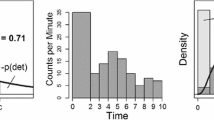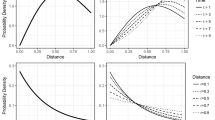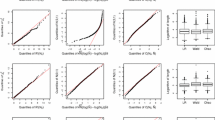Abstract
Conducting complete surveys on flora and fauna species within a sampling unit (or quadrat) of interest can be costly, particularly if there are several species in high abundance. A commonly used approach, which aims to reduce time and costs, consists of occurrence data reflecting the status of occupancy of a species– e.g., rather than counting every individual, the survey is stopped as soon as one individual has been observed. Although this approach is cheaper to conduct than a complete survey, some statistical efficiency in model estimators is lost. In this study, we consider occurrence data as a special case of right-censored count data where the collecting process stops until some set threshold on the number of observed individuals is reached. We then propose a new class of regression estimation models for right-censored count data that incorporate information from detection times (or catch effort) collected during sampling. First, we show that incorporating ancillary information in the form of detection times can greatly improve statistical efficiency over, say, right-censored Poisson or negative binomial models. Furthermore, the proposed models retain the same cost-effectiveness as censored-type models. We also consider zero-truncated and zero-inflated models for a variety of count data types. These models can be extended to a more general class of mixed Poisson models. We investigate model performance on simulated data and give two examples consisting of plant abundance data and bat acoustics data.
Supplementary materials accompanying this paper appear online.



Similar content being viewed by others
References
Baddeley, A. (2016). Spatial Point Patterns: Methodology and Applications with R. Boca Raton, FL: CRC Press/Taylor & Francis Group.
Barlow, K. E., Briggs, P. A., Haysom, K. A., Hutson, A. M., Lechiara, N. L., Racey, P. A., Walsh, A. L., and Langton, S. D. (2015). Citizen science reveals trends in bat populations: The National Bat Monitoring Programme in Great Britain. Biological Conservation 182, pp. 14–26.
Blakey, R. V., Law, B. S., Kingsford, R. T., and Stoklosa, J. (2017). Terrestrial laser scanning reveals below-canopy bat trait relationships with forest structure. Remote Sensing of Environment 198, pp. 40–51.
Blanchet, G., Legendre, P., and He, F. (2015). A new cost-effective approach to survey ecological communities. Oikos 125, pp. 975–987.
Brooks, J. D., Loeb, S. C., and Gerard, P. D. (2017). Effect of forest opening characteristics, prey abundance, and environmental factors on bat activity in the Southern Appalachians. Forest Ecology and Management 400, pp. 19–27.
Cameron, A. C. and Trivedi, P. K. (2013). Regression Analysis of Count Data, 2nd Edition Cambridge: Cambridge University Press.
Condit, R. (1998). Tropical Forest Census Plots. Berlin: Springer–Verlag and R. G. Landes Company.
Conlisk, E., Conlisk, J., and Harte, J. (2007). The impossibility of estimating a negative binomial clustering parameter from presence-absence data: a comment on He and Gaston. The American Naturalist 170, pp. 651–654.
Cruyff, M. J. and van der Heijden, P. G. (2008). Point and interval estimation of the population size using a zero-truncated negative binomial regression model. Biometrical Journal 50, pp. 1035–1050.
Diggle, P. J. (2003). Statistical Analysis of Spatial Point Patterns, 2nd Edition London: Arnold.
Elith, J., Graham, C. H., Anderson, P. A., Dudík, M., Ferrier, S., Guisan, A., Hijmans, R. J., Huettmann, F., Leathwick, J. R., Lehmann, A., Li, J., Lohmann, L. G., Loiselle, B. A., Manion, G., Moritz, G., Nakamura, M., Nakazawa, Y., McC. Overton, J., Peterson, A. T., Phillips, S. J., Richardson, K., Scachetti-Pereira, R., Schapire, R. E., Soberòn, J., Williams, S., Wisz, M. S., and Zimmermann, N. E. (2006). Novel methods improve prediction of species’ distributions from occurrence data. Ecography 28, pp. 129–151.
Greene, W. (2008). Functional forms for the negative binomial model for count data. Economics Letters 99, pp. 585–590.
Guillera-Arroita, G. (2017). Modelling of species distributions, range dynamics and communities under imperfect detection: advances, challenges and opportunities. Ecography 40, pp. 281–295.
Guillera-Arroita, G., Lahoz-Monfort, J. J., MacKenzie, D. I., Wintle, B.A., and McCarthy, M. A. (2014). Ignoring imperfect detection in biological surveys is dangerous: A response to “Fitting and interpreting occupancy models”. PLoS ONE 9, e99571.
He, F. and Gaston, K. J. (2000). Estimating species abundance from occurrence. American Naturalist 156, pp. 553–559.
He, F. and Reed, W. (2006). Downscaling abundance from the distribution of species: Occupancy theory and applications. In Scaling and Uncertainty Analysis in Ecology: Methods and Applications, J. Wu, K.B. Jones, H. Li, and O.L. Loucks (eds), 89–108. Dordrecht: Springer.
Hilbe, J. M. (2011). Negative Binomial Regression, 2nd Edition. Cambridge: Cambridge University Press.
Hubbell, S. P., Condit, R., and Foster, R. B. (2005). Barro Colorado Forest Census Plot Data. Available at http://ctfs.si.edu/webatlas/datasets/bci.
Hubbell, S. P., Foster R. B., O’Brien, S. T., Harms, K. E., Condit, R., Wechsler, B., Wright, S. J., and Loo de Lao, S. (1999). Light gap disturbances, recruitment limitation, and tree diversity in a neotropical forest. Science 283, pp. 554–557.
Huggins, R. M., Hwang, W. H., and Stoklosa, J. (2018). Estimation of abundance from presence-absence maps using cluster models. Environmental and Ecological Statistics 25, pp. 495–522.
Hwang, W. H. and Huggins, R. M. (2016). Estimating abundance from presence-absence maps via a paired negative binomial model. Scandinavian Journal of Statistics 43, pp. 573–586.
Hwang, W. H., Huggins, R., and Stoklosa, J. (2016). Estimating negative binomial parameters from occurrence data with detection times. Biometrical Journal 58, pp. 1409–1427.
Karlis, D. and Xekalaki, E. (2005). Mixed Poisson distributions. International Statistical Review 73, pp. 35–58.
Lawless, J. F. (1987). Negative binomial and mixed Poisson regression. The Canadian Journal of Statistics 15, pp. 209–225.
MacKenzie, D. I., Nichols, J. D., Royle, J. A., Pollock, K. H., Bailey, L. L., and Hines, J. E. (2017). Occupancy estimation and modeling: inferring patterns and dynamics of species occurrence, 2nd Edition. London: Elsevier/Academic Press.
Martin, T. G., Wintle, B. A., Rhodes, J. R., Kuhnert, P. M., Field, S. A., Low-Choy, S. J., Tyre, A. J., and Possingham, H. (2005). Zero tolerance ecology: improving ecological inference by modelling the source of zero observations. Ecology Letters 8, pp. 1235–1246.
Pettorelli, N., Baillie, J. E., and Durant, S .M. (2013). Indicator Bats Program: a system for the global acoustic monitoring of bats. In Biodiversity Monitoring and Conservation: Bridging the Gap between Global Commitment and Local Action, B. Collen, N. Pettorelli, J.E.M. Baillie and S.M. Durant (eds), 211–247. London: Wiley-Blackwell.
Pollock, K. H. (1991). Modeling capture, recapture, and removal statistics for estimation of demographic parameters for fish and wildlife populations: Past, present, and future. Journal of the American Statistical Association 86, pp. 225–238.
Ross, S. M. (2010). Introduction to Probability Models, 10th Edition. New York: Elsevier/Academic Press.
Rushton, S. P., Ormerod, S. J., and Kerby, G. (2004). New paradigms for modelling species distributions? Journal of Applied Ecology 41, pp. 193–200.
Schnitzler, H.-U., Moss, C. F., and Denzinger, A. (2003).From spatial orientation to food acquisition in echolocating bats. Trends in Ecology & Evolution 18, pp. 386–394.
Solow, A. R. and Smith, W. K. (2010). On predicting abundance from occupancy. American Naturalist 176, pp. 96–98.
Wang, Y., Naumann, U., Wright, S. T., and Warton, D. I. (2012). mvabund – an R package for model-based analysis of multivariate abundance data. Methods in Ecology and Evolution Evolution 3, pp. 471–474.
Warton, D. I., Blanchet, F. G., O’Hara, R. B., Ovaskainen, O., Taskinen, Walker, S. C., and Hui, F. K. C. (2015). So many variables: joint modeling in community ecology. Trends in Ecology & Evolution 30, pp. 766–779.
Wenger, S. J. and Freeman, M. C. (2008). Estimating species occurrence, abundance, and detection probability using zero-inflated distributions. Ecology 89, pp. 2953–2959.
Yee, T. W. (2015). Vector Generalized Linear and Additive Models. New York: Springer–Verlag.
Yin, D. and He, F. (2014). A simple method for estimating species abundance from occurrence maps. Methods in Ecology and Evolution 5, pp. 336–343.
Yip, P. S. F. and Wang, Y. (2002). A unified parametric regression model for recapture studies with random removals in continuous time. Biometrics 58, pp. 192–199.
Acknowledgements
The authors would like to thank the Handling Editor and two anonymous referees for their valuable comments. The authors would also like to thank R. Pretty for proofreading the manuscript. This work was supported by the Ministry of Science & Technology of Taiwan. The BCI forest dynamics research project was founded by S.P. Hubbell and R.B. Foster and is now managed by R. Condit, S. Lao, and R. Perez under the Center for Tropical Forest Science and the Smithsonian Tropical Research in Panama. Numerous organizations have provided funding, principally the U.S. National Science Foundation, and hundreds of field workers have contributed to this project. The bat data collection was conducted in collaboration with B.C. McLaughlin and W.F. Frick and was funded by the National Institute for Food and Agriculture, U.S. Department of Agriculture, McIntire Stennis project under 1006829.
Author information
Authors and Affiliations
Corresponding author
Additional information
Publisher's Note
Springer Nature remains neutral with regard to jurisdictional claims in published maps and institutional affiliations.
Electronic supplementary material
Below is the link to the electronic supplementary material.
Rights and permissions
About this article
Cite this article
Hwang, WH., Blakey, R.V. & Stoklosa, J. Right-Censored Mixed Poisson Count Models with Detection Times. JABES 25, 112–132 (2020). https://doi.org/10.1007/s13253-019-00381-3
Received:
Accepted:
Published:
Issue Date:
DOI: https://doi.org/10.1007/s13253-019-00381-3




